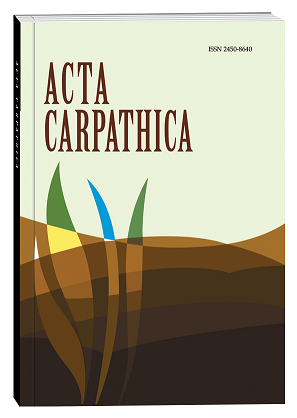ENVIRONMENTAL CHARACTERISTICS OF THE DNIESTER RIVER BASIN WITHIN THE SAMBIR DISTRICT
DOI:
https://doi.org/10.32782/2450-8640.2022.1.3Keywords:
Sambir district, Dniester River, environmental status, organoleptic parameters, pH, mineralization, chlorides, nitrogen compounds, phosphates, biotestingAbstract
The life quality of the population and the development of sectors of the economy in each country directly depends on the resource potential. Water resources are an important element since it is quite difficult to imagine any aspect of human life without water. Statistics show that the world's population has tripled in the twentieth century and water consumption has increased sixfold. Various human activities can adversely affect its environmental state, in particular its chemical and biological composition, on which the life of hydrobionts and the health of the population that consumes water depend. The malicious problem of today is to provide the population with water of appropriate quality and sufficient quantity. Data analysis from environmental passports and regional reports on the state of the environment in the Lviv region shows that the main pollutants of the surface waters of the region are nitrogen compounds, BOD5, chlorides, and phosphates. We investigated the environmental state of the Dniester River, which flows through the territory of the Sambir district. The study showed that all samples were normal according to the organoleptic characteristics of the indicator (transparency, smell). The pH of the tested water ranged from 6.2 to 7.3. Dniester river water mineralization ranged from 250 mg/l to 366 mg/l. The chloride ion content (Cl-) ranged from 6.25 mg/l to 15.94 mg/l. The ammonium compound concentration in water was within 0.59 mg/l to 1.71 mg/l and sometimes exceeded the maximum permissible concentration. The concentration of NO2- in water samples ranged from minimum values of 0.005 mg/l to maximum values of 0.077 mg/l. Nitrates were found in quantities of 3.2 mg/l – 15 mg/l. The phosphate content ranged from 0.2 mg/l to 0.38 mg/l. The biotests of Dniester River waters were performed using Allium cepa plant test. The phytotoxicity level of the Dniester River water was also studied and it was found that it fluctuated between 28.3–51.1%. This corresponds to a medium toxicity level and does not cause a cytotoxic effect.
References
Бриндзя І.В. Екологічна оцінка перетворення неорганічних сполук нітрогену у колодязях Прикарпаття: авторф. дис.канд. біо. наук. Київ, 2017. 23 с.
Волошкіна О.С., Гандзюра В.П. Екологічні основи управління водними ресурсами: навч. посіб. Київ, 2017. 49 с.
Гідроекологічна характеристика річки Дністер. URL:https://knowledge.allbest.ru/geology/3c0a65635b2ac79a5c53a88421206d27_0.html (дата звернення 01.11.2022 р.)
Ісаєнко В.М., Лисиченко Г. В., Дудар Т. В. Моніторинг і методи вимірювання параметрів навколишнього середовища: навчальний посібник. Київ: Нац. авіац. ун. «НАУ–друк», 2009. 112 с.
Кучеренко Т.В., Головатюк Є.О. Використання біотесту Allium cepa L. (цибуля звичайна) для оцінювання антропогенного забруднення навколишнього середовища. Агроекологічний журнал. 2008. № 4. С. 79–83
Левківський С.С., М.М. Падун. Раціональне використання і охорона водних ресурсів: навч. посіб. Київ: Либідь, 2006. 60 с.
Медінець В.І., Конарева О.П., Ковальова Н.В., Солтис І.Є. Екологія міст та рекреаційних зон : Всеукраїнська науково-практична конференція. Одеса, 2009. 87 с.
Постанова КМУ Про затвердження Положення про державну систему моніторингу довкілля від 30 березня 1998 р. № 391, Київ. URL:https://zakon.rada.gov.ua/laws/show/391-98-%D0%BF#Text (дата звернення 08.11.2022 р.)
Руденко С.С., Костишин С.С., Морозова Т.В. Загальна екологія: практ. курс, ч. 1. Чернівці: Рута, 2003. 320 с.
Старикович Л.С., Дудок К.П., Любас Н.М. Прилади та методи дослідження стану довкілля. Львів: ЛНУ, 2014. 196 с.
Степова О.В., Рома В.В. моніторинг поверхневих вод: навч. посіб. Полтава: ПолтНТУ, 2017. 21 с.
Хільчевський В.І. Хільчевський В.К., Осадчий В.І. Основи гідрохімії: підручник К.: Ніка-Центр, 2012. с. 44.
Царенко О.М. та ін. Захист довкілля в умовах зростаючого техногенного навантаження на природу: навч. посіб. Суми: Слобожанщина, 2002. 464 с.
Шевчук В.М., Третяк С. К., Бурштинська Х. В. Моніторинг змін русла річки Стрий з використанням ГІС–технологій. Cучасні досягнення геодезичної науки та виробництва. 2018. Вип. 1. С. 138–139.








